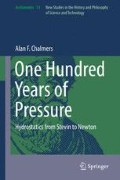Abstract
Pascal began his Equilibrium of Liquids, written around 1654, by noting some counter-intuitive experimental results. He then utilized what is now known as the hydraulic press to introduce his theory of how a liquid can function as a machine for multiplying force. A pressing at one location on the boundary of a liquid, measured as a force per unit area, is instantaneously transmitted to any other location on the boundary, however orientated, as the same force per unit area. This takes place on account of the continuity and fluidity of the liquid. In the remainder of his short book Pascal showed how his theory could account for a range of phenomena, some long familiar, such as floatation, and others less so, such as the deflation of an inflated bladder when lowered in water. The reliance on experiment stood in contrast to the demand that propositions of a science should be derived from postulates grantable at the outset. The significant moves made by Pascal towards the technical sense of pressure retained the common conception that pressure acts on the boundary between a liquid and a solid and did not consider pressures acting in the body of liquids. Pascal’s, somewhat exaggerated, stress on the debt of his hydrostatics to novel experiments probably stemmed from his involvement with pneumatics.
Access this chapter
Tax calculation will be finalised at checkout
Purchases are for personal use only
Notes
- 1.
The original, Dutch version of Stevin ’s Elements of Hydrostatics had been translated into Latin in 1608 and into French in 1634.
- 2.
Pierre Duhem (1905, pp. 602–604) made a case for Pascal’s familiarity with the details of Stevin ’s Elements of Hydrostatics.
- 3.
- 4.
Pascal (1937, p.8). I have altered the translation by Spiers and Spiers to render it more compatible with the original French, ‘qui ne pourra être entendue que par les seuls géomètres, et peut être passée par les autres’.
- 5.
I have altered the English translation to avoid using the noun ‘pressure’, thereby lessening the danger of mistakenly attributing to Pascal what is entailed by the modern, technical, usage of that expression. The French version of this crucial passage reads ‘de sorte que si un vaisseau plein d’eau n’a qu’une seule ouverture, large d’un pouce, par exemple, où l’on mette un piston chargé d’un poids d’une livre, ce poids fait effort contre toutes les parties du vaisseau généralement, à cause de la continuité et de la fluidité de l’eau; mais, pour déterminer combine chaque partie souffre, en voici la règle. Chaque partie large d’un pouce, comme l’ouverture, souffre autant que si elle était poussée par le poids d’une livre (sans compter le poids de l’eau dont je ne parle pas ici, car je ne parle que du poids du piston) parce que le poids d’une livre presse le piston qui est. à l’ouverture, et chaque portion du vaisseau plus ou moins grande souffre précisément plus ou moins à proportion de sa grandeur, soit que cette portion soit vis-à-vis de l’ouverture ou à côté, loin ou près; car la continuité et la fluidité de l’eau rend toutes ces choses-là égales et indifférentes.’ (Pascal 1970, p. 1046.)
- 6.
The context indicates that Pascal should have asserted the forces to be inversely rather than directly proportional to distance.
- 7.
In On Mechanics, when discussing the balance and the steelyard, Galileo noted that lifting a heavy weight by one weighing only a fifth as much situated five times further from the fulcrum of a steelyard was equivalent to lifting five times a weight five times smaller by means of a steelyard with equal arms . See Drabkin and Drake (1960, p. 159).
- 8.
I here write ‘force’ for the original French ‘force’, replacing the term ‘efficacy’ in the translation by Spiers and Spiers, the latter term being too readily interpretable in a way that suggests Pascal came closer to appreciating something like the conservation of energy than is warranted.
- 9.
Witness the gentleman in the last of the figures in Plate 1, reproduced in my Fig. 6.1.
- 10.
Alexander Koyré (1968, pp. 147–154) raised reasons to doubt whether Pascal actually performed experiments requiring such long tubes. Boyle redesigned Pascal’ syphon experiment by replacing mercury with water and water with oil of turpentine. What is more, he actually performed the experiment and found it to live up to Pascal’s expectations. Boyle ’s version of the experiment is described in Boyle (1999, Vol. 5, pp. 255–258).
References
Boyle, R. 1999. The works of Robert Boyle. 14 volumes, eds. M. Hunter and E. Davis. London: Pickering and Chatto.
Dijksterhuis, E.J. 1955. The principal works of Simon Stevin, Volume 1, Mechanics. Amsterdam: Swets and Zeitlinger.
Drabkin, I.E., and S. Drake. 1960. On motion and on mechanics. Madison: University of Wisconsin Press.
Duhem, P. 1905. Le Principe de Pascal. Revue Générale des Sciences Pures et Applique. 16: 599–610.
Koyré, A. 1968. Metaphysics and measurement: Essays in the scientific revolution. London: Chapman and Hall.
Mersenne, M. 1644. Cogitata Physico-mathematica. Paris: Antoni Bertier.
Pascal, B. 1937. The physical treatises of Pascal: The equilibrium of liquids and the weight of the mass of the air. Trans. A.G.H. Spiers and I.H.B. Spiers. New York: Columbia University Press.
———. 1970. Blaise Pascal: Ouevres Complète, Volume 2, ed. J. Mesnard. Paris: Desclèe de Brouwer.
Torricelli, E. 1644. Opera geometrica. Florence: Amatoris Massae and Lauenti de Landis.
Author information
Authors and Affiliations
Rights and permissions
Copyright information
© 2017 Springer International Publishing AG
About this chapter
Cite this chapter
Chalmers, A.F. (2017). Pascal’s Equilibrium of Liquids . In: One Hundred Years of Pressure. Archimedes, vol 51. Springer, Cham. https://doi.org/10.1007/978-3-319-56529-3_6
Download citation
DOI: https://doi.org/10.1007/978-3-319-56529-3_6
Published:
Publisher Name: Springer, Cham
Print ISBN: 978-3-319-56528-6
Online ISBN: 978-3-319-56529-3
eBook Packages: Physics and AstronomyPhysics and Astronomy (R0)

